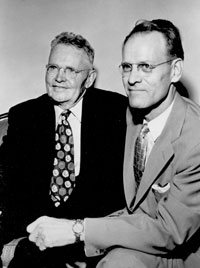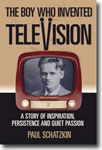

 |
The Farnsworth
Invention: Fact -v- Fiction
|
 |
Act II, Scene 6: Where the train finally plunges off the tracks. |
| The Play |
The Facts
|
|
| "Here's Herbert Hoover talking about television...." -- and saying that it could only have been the product of a corporation. |
Herbert Hoover appeared on an AT&T experimental (mechanical) television system while he was Secretary of Commerce in 1927. And he might be right: the contraption that transmitted Hoover's image from Washington to Baltimore could only have been designed and constructed by somebody with the wrong idea and lots of corporate support. The essence of this whole story is that television, as impossibly complex
as it was supposed to be, was in fact borne whole from the mind of single,
uniquely inspired individual. Others had similar ideas but could not reduce
them to actual practice. To have the right idea is one thing; to have
the right idea and MAKE IT WORK is EVERYTHING. |
|
| While preparing their patent interference briefs, Justin Tolman -- Farnsworth's freshman high school science teacher --comes in, and shows the lawyers the sketch that Philo drew for him "first week of September, 1921..." | Needing to establish Farnsworth's date of conception prior to Zworykin's 1923 patent application, his lawyers went to Idaho and managed to track down Justin Tolman. They were astonished when Tolman produced the sketch that Farnsworth had drawn for him in March of 1922. Because the drawing was not dated or notarized, and because Tolman could not be regarded as an expert witness, the patent examiners rejected his testimony and evidence as inadmissible. However, that rejection had no bearing on the final outcome of the case. |
 Justin Tolman and Philo T. Farnsworth were reunited at a 1953 banquet in Salt Lake City |
| Court is now in session. The witnesses are introduced. Zworykin begins
to testify. And then, as Sarnoff narrates, "something incredible is
about to happen..." Moments later, Farnsworth starts ranting that Zworykin
"stores the light..." |
This is the climactic scene in the play, and the pivotal moment in the true Farnsworth story, but nearly everything about this scene is a fabrication.Suffice it to say, Farnsworth did not go ballistic in the middle of a court room upon discovering some secret of Zworykin's Iconoscope. What this scene does is reduce Farnsworth's achivement -- what has been dubbed "a breakthrough of epic proportions" -- to a "light problem" that somebody else supposedly solved. This interpretation meshes poorly with the facts, to put it mildly. The issues here are complex, to be sure, but not incomprehensible: RCA tried to make the case Zworykin's new tube -- the Iconoscope -- was the same tube he had disclosed in his 1923 application (patent still pending in 1934), AND that it operated in the same manner as disclosed in Farnsworth's 1927 application (patent granted in 1930). But Farnsworth's patents, written and defended by Farnsworth and Donald Lippincott, were air-tight and iron-clad. RCA's long record of crushing independent inventors was about to meet its match. |
|
| "The lawyers were also unable to recognize the signs of a nervous breakdown.... " | Oh, please. Farnsworth was in complete command of all his faculties through this period and the defense of his patents was every bit as brilliant as it was successful. He was dealing with multiple stress factors from a myriad of directions, to be sure, but he nowhere near a "nervous breakdown" during the period in the mid 1930s when his patents were in dispute. | |
| A judge comes in and renders a verdict: "Priority of invention is awarded to Vladimir Zworykin." | And that sound you hear is the sound of a locomotive plunging into a ravine. The 1934 interference focused primarily on Claim 15 in Farnsworth's 1930 patent, the one that defined the "electrical image." Zworykin's lawyers had tried to show that his new tube produced an electrical image as defined in the claim, and that the concept was part of Zworykin's 1923 patent application. The patent examines found otherwise, and in their decision #64,027 rendered (by mail, not in a court room) in July, 1935, concluded that Zworykin had 'no right to make the count' for at least three reasons and so "priority of invention" was awarded to "Philo. T. Farnsworth." Thus the climactic scene in the play ends with an historically false conclusion. |
|
| The judge also "authorizes the commissioner of patents to approve the original 1923 application..." | Now the play is conflating two unrelated cases. Farnsworth WON the 1934 interference awarding priority of invention over the essential principles of electronic television (i.e. the "electrical image" disclosed in Claim 15). That victory was predicated in part on the patent court's determination that Zworykin's 1923 application was "inoperable" -- in the words of the play, "it didn't work." But RCA continued for another three years trying to finagle a patent based on Zworykin's 1923 application. They finally succeeded in 1938 with the issuance of patent #2,141,059 -- an extensively amended document that bears little resemblance to Zworykin's original application other than the application date of December, 1923. Nevertheless, RCA would for decades thereafter build a public relations juggernaut around the claim that "Vladimir Zworykin invented the Iconoscope for RCA in 1923" -- a single statement that manages to embody no less than three falsehoods that this play does nothing to correct. |
|
After the court adjourns, Sarnoff comes on stage and waffles: "We may have one that first one and lost on appeal, or lost and then won and lost again.. I don't know..." |
Well, he should know: The fact is that RCA lost every case it engaged against Farnsworth throughout the 1930s. Finally, in 1939, RCA -- the company that was formed "to collect patent royalties, not pay them" -- capitulated to the Farnsworth Television and Radio Company (by then relocated to Fort Wayne, Indiana), accepted a license to use Farnsworth's patents, and paid the Farnsworth company $1-million. This payment marked the first time in its history that RCA paid any sum to another company for the use of patents. This capitulation was unavoidable once RCA discovered that patents covering the essential elements of a new camera tube called the Image Orthicon -- which was based in part on the Image Dissector and provided the ultimate solution to all the "light problems" -- belonged to Philo T. Farnsworth. Farnsworth solved the "light problem" himself, and when he did, David Sarnoff and RCA had no choice but to license his patents or get out of the television business altogether. But the play doesn't say anything about that. Nor did that stop RCA from professing for decades thereafter that television was invented in their laboratories, strictly on the basis of having solved the "light problem." |
|
Want the whole story? Read a Book! |
 The Boy Who Invented Television A Story of Inspiration, Persistence, and Quiet Passion by Paul Schatzkin |
|